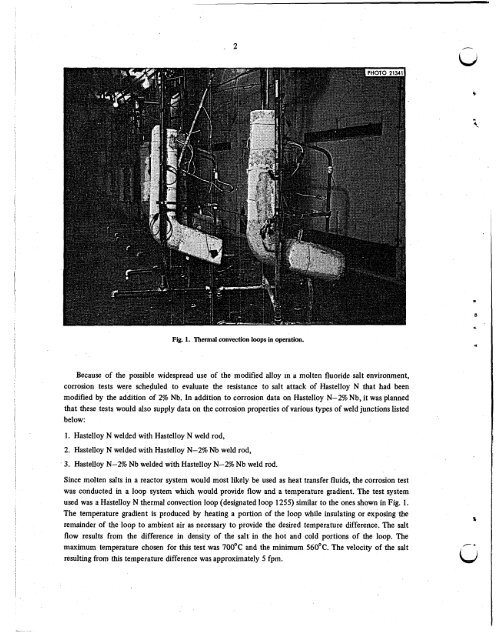Evaluation of hastelloy N alloys after nine years exposure to both a ...
Evaluation of hastelloy N alloys after nine years exposure to both a ...
Evaluation of hastelloy N alloys after nine years exposure to both a ...
Create successful ePaper yourself
Turn your PDF publications into a flip-book with our unique Google optimized e-Paper software.
2<br />
Fig. 1. Thermal convection loops in operation.<br />
Because <strong>of</strong> the possible widespread use <strong>of</strong> the modified alloy in a molten fluoride salt environment,<br />
corrosion tests were scheduled <strong>to</strong> evaluate the resistance <strong>to</strong> salt attack <strong>of</strong> Hastelloy N that had been<br />
modified by the addition <strong>of</strong> 2% Nb. In addition <strong>to</strong> corrosion data on Hastelloy N-2% Nb, it was planned<br />
that these tests would also supply data on the corrosion properties <strong>of</strong> various types <strong>of</strong> weld junctions listed<br />
below:<br />
1. Hastelloy N welded with Hastelloy N weld rod,<br />
2. Hastelloy N welded with Hastelloy N-2% Nb weld rod,<br />
' 3. Hastelloy N-2% Nb welded with Hastelloy N-2% Nb weld rod.<br />
Since molten salts in a reac<strong>to</strong>r system would most likely be used as heat transfer fluids, the corrosion test<br />
was conducted in a loop system which would provide flow and a temperature gradient. The test system<br />
used was a Hastelloy N thermal convection loop (designated loop 1255) similar <strong>to</strong> the ones shown in Fig. 1.<br />
The temperature gradient is produced by heating a portion <strong>of</strong> the loop while insulating or exposing the<br />
remainder <strong>of</strong> the loop <strong>to</strong> ambient air as necessary <strong>to</strong> provide the desired temperature difference. The salt<br />
flow results from the difference in density <strong>of</strong> the salt in the hot and cold portions <strong>of</strong> the loop. The<br />
maximum temperature chosen for this test was 700°C and the minimum 560°C. The velocity <strong>of</strong> the salt<br />
resulting from this temperature difference was approximately 5 fpm.



![Review of Molten Salt Reactor Physics Calculations [Disc 2]](https://img.yumpu.com/21979492/1/190x247/review-of-molten-salt-reactor-physics-calculations-disc-2.jpg?quality=85)













